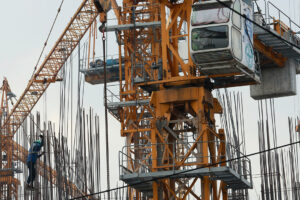By Abigail Marie P. Yraola, Deputy Research Head
APPROVED building permits fell by 9% year on year in June, as high interest rates dampened construction activity, the Philippine Statistics Authority (PSA) said in a report on Thursday.
Preliminary data on construction statistics showed that building projects covered by the permits declined to 13,170 in June from 14,477 a year ago.
In June, building projects covered 2.66 million square meters (sq.m.) of floor area, 7% higher than the 2.49 million sq.m. in June last year.
John Paolo R. Rivera, senior research fellow at the Philippine Institute for Development Studies, said in a Viber message that construction activities slowed down in June likely due to high interest rates. This may have discouraged developers and construction firms from taking on loans to finance projects.
The Bangko Sentral ng Pilipinas (BSP) had kept policy rates at a 17-year high of 6.5% from October 2023 to mid-August this year. At its August meeting, the BSP cut rates by 25 basis points to 6.25% amid a downtrend in inflation.
PSA data also showed construction projects represented by the permits were valued at P34.16 billion in June, up 4.4% from P32.72 billion a year ago.
“While the value of these projects increased, the overall number of permits suggests a decrease in demand or a shift in project types,” Robert Dan J. Roces, chief economist at Security Bank Corp. said in a Viber message.
Based on the second-quarter gross domestic product (GDP) figures, Mr. Roces said construction was the top performing sector.
In the April-to-June period, Philippine GDP expanded by 6.3% year on year, which was the fastest in five quarters. Public construction grew by 21.8% in the second quarter, as the government ramped up infrastructure and rehabilitation projects. Private construction also rose by 9.9%, with commercial construction increasing by 13.6%.
However, Mr. Roces said factors that may have contributed to the drop in building permits include rising interest rates, economic uncertainty, material shortages, regulatory changes, and shifts in market preferences.
However, he highlighted that government infrastructure projects, housing demand, and economic recovery could provide support for the construction sector in the future.
PSA data showed permits for residential projects, which accounted for 67.8% of the total, fell 7.5% to 8,933 in June from 9,655 a year earlier.
These projects were valued at P17.05 billion, compared with P15.54 billion in June last year.
Single homes accounted for 82.6% of the residential category, with approved permits declining 7.4% to 7,377 in June.
Permits for apartment buildings dropped by 21.7% to 1,243, while permits for duplex or quadruplex homes surged 331% to 306.
On the other hand, nonresidential projects declined 8.3% year on year to 2,621 building permits.
Nonresidential permits were valued at P13.96 billion and accounted for 19.9% of the total.
Approved commercial construction applications, which made up 68.9% of all nonresidential projects, slid by 12.5% to 1,806 in June.
Meanwhile, institutional building permits fell by 3.4% to 427, while industrial permits rose by 13.1% to 216.
In June, approved agricultural projects declined by 11.9% to 74 while other nonresidential projects climbed by 27.3% to 98 on an annual basis.
Alteration and repair permits slipped by 6.1% to 962 in June. These were valued at P2.02 billion.
On the other hand, permits for additions — construction that increases the height or area of an existing building — declined by 30.9% to 391.
By region, Calabarzon (Cavite, Laguna, Batangas, Rizal, and Quezon) accounted for 21.3% of approved construction projects with 2,811 permits, followed by Central Luzon (2,202 permits), and Central Visayas (1,638 permits).
Mr. Rivera expects building permit approvals to improve amid further easing by the central bank.
For Mr. Roces, the construction sector faces headwinds from elevated interest rates, economic uncertainty and shortages in materials.
“While there are potential upsides, government policies and investments will be crucial in supporting the industry’s recovery,” Mr. Roces said.
The PSA said construction statistics are compiled from the copies of original application forms of approved building permits as well as from demolition and fencing permits collected monthly by the agency’s field personnel from the offices of local building officials nationwide.






